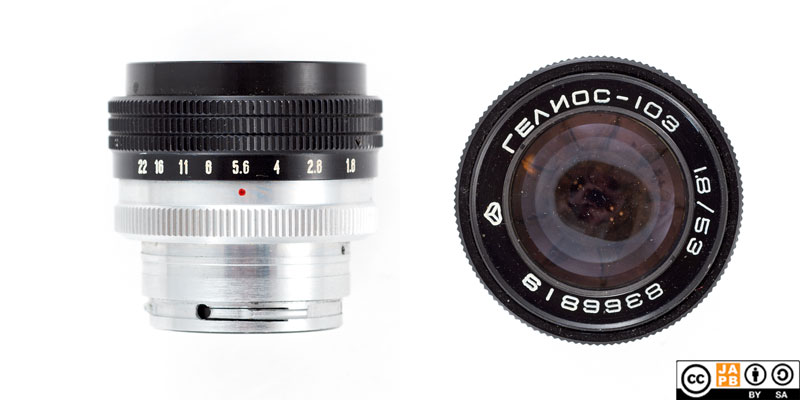Pekka Buttler, 09/2023

Specifications
The table below summarizes the lens’ key specifications (measurements based on pictured lens):
| Manufacturer: | Arsenal | Lens name | Гелиос-103 / Helios-103 1.8/53 |
| Focal length(s) 1 | 53 mm | Angle-of-view 2 | 44 ° |
| Maximum Aperture | f/1.8 | In Production | 1978–1985 |
| Lens mounts | Contax/Kiev | Subfamily (if applicable) | –– |
| Length | 30,4 mm (from flange3) 45,8 mm (entire length) | Diameter 4 | 47,8 mm |
| Filter ring diameter | 40,5 mm | Weight | 150 grams |
| Lens element count | 6 | Lens group count | 4 |
| Aperture blades (S/R/C) 5 | 9 S | Focus throw | N/A |
| Minimum focusing distance | 1 m | Maximum magnification | 1:16,8 |
| Has manual aperture ring | YES | Has Manual focus ring | NO |
| Aperture mechanism type | Manual | Aperture click stops 6 | 1.8-2.8-4-5.6-8-11-16-22 |
Further notes:
• The Helios-103 was introduced in 1978 as a standard lens for Kiev rangefinder cameras (the Soviet copy of the German Contax rangefinder). It’s a relatively modern design that is based on a nearly symmetrical Double-Gauss design.
• Unlike many other Soviet rangefinder lenses, this lens was manufactured only with the Contax/Kiev mount (and not also the LTM mount). Hence it was also only produced at the Arsenal plant in Kiev.
• Because it is a standard lens for the Contax/Kiev mount lens, it uses the mount’s integrated focusing mechanism. Hence the lens lacks a focus ring of its own.
• Because the entire lens will rotate when used, the aperture ring’s markings are duplicated (up and down)
• The aperture ring fully manual and ofers very satisfying clicks.
• While the lenses carry no markings to indicate their coating, one must assume some coating approach was used.
History of Helios and other Soviet lenses
If you’re interested, I recommend you read JAPB’s article about the Soviet lens ‘business’.
Versions
While this lens did not have an especially long production run (for a Soviet lens) its design was nevertheless updated in 1982 to feature a broader and subdivided focusing ring. There are no indications of this coinciding with a update of the optics. Also, domestic (cyrillic) versions are usually kept separate from export (latin) versions. Finally, in 1993–1995 a new batch of these lenses was produced under the diverging name ‘Menopta’. See more details here.
Adapting
To use this lens natively, you will need either a Contax rangefinder body or a Kiev rangefinder body. Of these, the Kiev rangefinder bodies were produced in greater numbers, and their production also continued long past the end of production of Contax rangefinders. On the other hand, quality control at the Kiev plant was never quite up to German standards, and Kiev bodies are more likely not to have had proper maintenance. In an absolute pinch, you can even mount this lens on a Nikon S series, but be prepared that the rangefinder will be off a bit.
If your intention is to adapt this lens to a mirrorless camera, that is certainly possible, but you will need an adapter that offers the lens the Contax/Kiev mount’s internal bayonet. Problematically internal bayonet adapters are less common than external bayonet adapters (or adapters that offer both bayonets). In any case, the range of available adapters is not as wide as with some of the more common SLR mounts (e.g. Canon FD …) and you should not expect special adapters (helicoid adapters, tilt/shift adapters, speed boosters) to be available.
Due to the short flange focal distance used by the Contax/Kiev mount, there is no meaningful way to adapt this lens to any SLR or dSLR.
Footnotes
- Focal length is (unless stated otherwise) given in absolute terms, and not in Full-frame equivalent. For an understanding of whether the lens is wide/tele, see ‘Angle-of-view’. ↩︎
- Picture angle is given in degrees (based on manufacturers’ specs) and concerns the diagonal picture angle. Rule of thumb:
> 90 ° ==> Ultra-wide-angle
70–90 ° ==> Wide-angle
50–70 ° ==> Moderate wide-angle
40–50 ° ==> ‘Standard’ or ‘normal’ lens
20–40 ° ==> Short tele lens
10-20 ° ==> Tele lens
5-10 ° ==> Long tele lens
< 5 ° ==> Ultra-tele lens ↩︎ - Length is given from the mount flange to the front of lens at infinity. ↩︎
- Diameter excludes protrusions such as rabbit ears or stop-down levers. ↩︎
- S=straight; R=rounded; C=(almost)circular at all apertures. ↩︎
- Numbers equal aperture values on aperture ring; • intermediate click; – no intermediate click. ↩︎